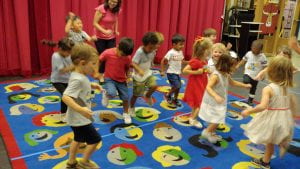Drama is… serious business
We’ve had a busy start to the year! It was a great to see parents attending Meet the Teacher Night to learn about what we do in the drama classroom. I stress that PARTICIPATION is key to success, and we had some parents doing just that in an exercise called Stage Picture. I hope questions were answered in the time we enjoyed together. If you for some reason you weren’t able to attend, here is a link – Lower School Drama Meet the Teacher
This blog focuses on Pre-school, Kindergarten and 1st grade
Drama is… serious business 
I think students, even parents, may be somewhat surprised with all that we do in drama class. We’re not just learning lines and putting on plays. There is so much more to the craft of acting. Can you imagine an ice skater trying to qualify for the Olympics having only trained for a year? Absurd! Can you even conceive of an eye surgeon to be an expert in his field, but having never actually studied the human eye? Insane. Studying theatre arts is a discipline that also takes training over time. Specifically, acting is the study and communication of human behavior. Actors use their bodies and voices to communicate all kinds of human struggles and experiences. The actor’s instrument is made up of: the physical, the emotional, the imagination, sensory expression, logical thinking and more! In simple terms – the tools the actor needs to do drama are: The body. The voice. The mind (imagination). Each of these tools must be exercised and developed. Of course, this does not happen overnight, but is a life-long process of learning and discovery.
In the drama room at Quest we begin each class with a vocal and physical warm-up – fundamental to the actor’s  creative process. This helps the student transition from their prior thinking to the actor’s thought process. It also helps students to establish a pattern (of order) to the actor’s work. The warm-up often consists of a physical, a vocal, and a group component. The physical and vocal parts prepare the students to use their bodies as tools on the stage, while the group piece creates energy, directs focus, and serves as an ensemble builder.
creative process. This helps the student transition from their prior thinking to the actor’s thought process. It also helps students to establish a pattern (of order) to the actor’s work. The warm-up often consists of a physical, a vocal, and a group component. The physical and vocal parts prepare the students to use their bodies as tools on the stage, while the group piece creates energy, directs focus, and serves as an ensemble builder.
With our youngest students (Pre-school/Junior Kindergarten) we begin each year developing and stretching the imagination. In the study of acting we call this the MAGIC IF – pretending as is something is real. We’ve explored various way to use the imagination.
In Kindergarten and 1st grade not only are we exercising our imagination muscles, we always begin working on a vital drama concept – GIVE AND TAKE. You cannot do the actor’s work without it. An actor knows when to give focus to another actor and when to take focus. If an actor is speaking, all eyes and ears should be on her. When it’s time to speak or move the action forward, the actor commits fully with strong energy and takes the focus. As we develop this skill, students learn readiness – ready to speak, ready to share an idea, students learn collaboration – the importance of everyone’s contribution.
drama concept – GIVE AND TAKE. You cannot do the actor’s work without it. An actor knows when to give focus to another actor and when to take focus. If an actor is speaking, all eyes and ears should be on her. When it’s time to speak or move the action forward, the actor commits fully with strong energy and takes the focus. As we develop this skill, students learn readiness – ready to speak, ready to share an idea, students learn collaboration – the importance of everyone’s contribution.
 The students are all at different levels and learning at their own pace. Some students think that drama class is a time to release a lot of energy, be silly and show off, BUT they will learn that their energy needs to be focused so that it produces clear and engaging action – that seems “as if it’s real.” You will hear me say… “It’s not time to be silly but SERIOUS.”
The students are all at different levels and learning at their own pace. Some students think that drama class is a time to release a lot of energy, be silly and show off, BUT they will learn that their energy needs to be focused so that it produces clear and engaging action – that seems “as if it’s real.” You will hear me say… “It’s not time to be silly but SERIOUS.”